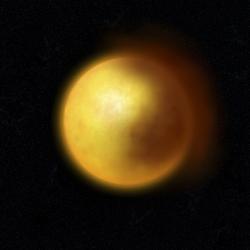Scientists from France and Brazil have discovered the secret of a rare type of irregular variable star

Most stars shine with a bright light that does not change for billions of years. Others change their brightness dramatically, dimming and brightening in fixed periods of days, weeks or months. Each type of star changes and the reason for this is that some of them are in pairs that when they are separated they look like a bright star to us, and when one hides the other, the light coming from the system is small, and there are also variables whose light change is caused within them as a result of physical processes. One type, known as R Coronae Borealis These are irregular variable stars, meaning that their brightness and dimming cycles are uneven. Astronomers now know why: they are hiding behind a blanket of dust.
An international team of astronomers from France and Brazil discovered a huge cloud of gas surrounding a star of the type R Coronae Borealis, named RY Sagittarii, which lies 6,000 light-years from Earth in the direction of the Sagittarius group. This discovery led to the theory that these stars wrap themselves in a blanket of dust and hide themselves from us.
According to the theory formulated by the discoverers, these stars, which are 50 times larger than the Sun, are constantly emitting a mantle of dust that surrounds them. When these clouds move into the line of sight between us and the star, they cause the star to be eclipsed. From our perspective on Earth, the star dims and brightens. As the star's radiation scatters the dust particles, the star brightens back up.
The researchers used the European Southern Observatory's Very Large Telescope interferometer in Chile to detect the presence of dust around the variable star RY Sagittarii. It was the first time that a dust cloud of this type had been directly detected. The dust, which reflects the light can be detected up to a distance of several radii from the center of the star, so it is clear that it is drifting. They discovered that a large shell surrounds the star with an area 120 times larger than RY Sagittarii itself.
The cloud was moving at a speed of 300 kilometers per second, so the astronomers calculated that it must have been ejected almost six months before it was discovered. They plan to make follow-up observations of RY Sagittarii to understand how these dust clouds formed and how they are dispersed.

5 תגובות
my father
My opinion about the albedo!
Only planets that have no light of their own have an albedo
The albedo determines the ratio between the reflected light and the incident light
A star that has its own light has no effect on albedo.
my father
Wow, ok, thanks.
It was not clear to me that six thousand years or thousands of years are automatically subtracted in such cases. All in all, we are talking about a phenomenon that occurred "six months ago" today six thousand years ago! not trivial…
Thanks for the info, I learned.
6,000 light years towards the Sagittarius group. From the press release of the European Southern Observatory.
It's all true, by the way my mistake was not looking for the distance to that star in light years, I guess not many because otherwise it would not have been possible to discover such a phenomenon - especially this is serious because I ask other writers for it but that's how it is when you work in the middle of the night and immediately upload.
Regarding the other questions, it is clear that this is a few months ago plus the time it took for the light to arrive and not our time, our time has no meaning except in the immediate environment. For the convenience of the description, this figure is ignored.
Hi Abby,
Thank you very much for the explanation
I actually happened to read the article on YNET
In any case, I wanted to ask - because I really don't understand anything about astronomy (not even about astrology):
If a star constantly emits all kinds of dark or black substances that absorb the light, then its albedo is very low. If it is shrouded in smoke or a black cloud, it won't be visible at all - right?
The second question is, this star, I guess, is light years away from us. Which means that the event we are seeing is an event that happened a few years ago - isn't it? If so, how can we talk about when the phenomenon occurred? At the end of the article you write "that the astronomers calculated that it was ejected almost certainly six months before it was discovered". Is it correct to assume that these six months are not in our time, but years ago, a number of Halacha in practice?
Thanks in advance for the response,
Ami